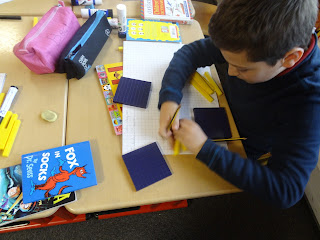This was really to address that we call the rhombus a diamond, without getting all vocabulary-ish in the process.
It made me wonder...
Could we make a WODB about sets of shapes?
The aim: look at categories, and the idea of inclusion and exclusion based on a criterion, starting with not vocabulary but the students observations and thinking.
So I've rustled up four sets of quadrilaterals:
I'm planning to do this tomorrow in three stages:
- Students look in pairs at what the members of each set have in common . What are its defining features?
- Students share what they think.
- Then, after we've got a thorough feel for the four sets, we do the normal Which One Doesn't Belong?
I don't know how it's going to work. Am I putting too much in? First of all looking for what's the same, then looking for what's different?
Or will it be a feast of thinking and generalisation-making?
I'm encouraged that everyone's got a good grasp of how WODBs work, and can make their own, justifying the inclusion of each corner.
and I was really pleased when a student came in with her own home-made WODB this morning, and wanted to run it with the class (she's got another one, but one a day is enough):
So, if the class were ever stoked up for this challenge, it's now.
Just in case dealing with sets is too much of a stretch, or in case students go down the vocabulary road, I'm going to keep in the wings a few statements from
the Always, Sometimes, Never list, and we'll switch to these if it's what's needed:
- A square is a rectangle.
- A rectangle is a square.
- A rectangle has two long sides and two short sides.
- All four sides of a square have the same length.
- Parallelograms are slanted rectangles.
--o--
There's another dimension to the lesson. I'm looking, with Estelle, at how to design talk that helps learning. We're reading
Making Thinking Visible, and I'm really impressed by the tone and content of the book, and before I'm even on to the book's thinking moves, I want to try to use its analysis as a guideline, to set up talk that around different kinds of thinking:
Naturally, there's
- Observing
Closely
and
Describing
What’s
There
- Building
Explanations
and
Interpretations
- Reasoning
with
Evidence
But I'm also keen to get the students' listening going with
- Considering
Different
Viewpoints
and
Perspectives
I'm hoping that the pair work will give lots of opportunity for this. I'm going to ask them to pay especial attention to what their partner says, and note this down, so that they can report back on this.
Estelle's coming in to observe the lesson, and I'm hoping she'll pick up on ways the students are talking to each other that are helping their thinking.
I've just started a system for making sure everyone works with (almost) everyone at some point. Each student had to choose a 'Bucharest partner', then a 'Bangalore partner', then a 'London partner' and so on and note down all these 'Place Partners' on a list. The result (after me going through the choices) is a matrix that looks like this (with the names taken off):
(There's a few gaps (black) but I'll try and pair those up another time.) It's important that the students can and do work with everyone in the class, not just he ones that they get on with. So tomorrow it will be the London partners.
After the paired work looking at the sets, we'll come together to share and look at the WODB. I think they might need steering through this.





























































